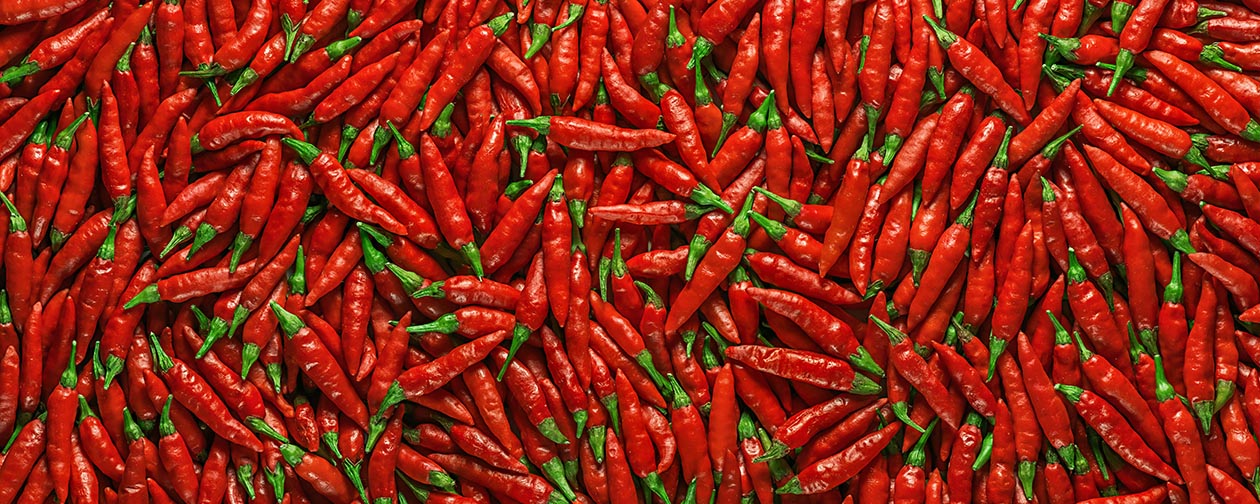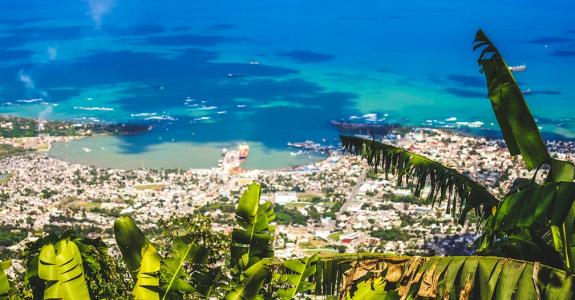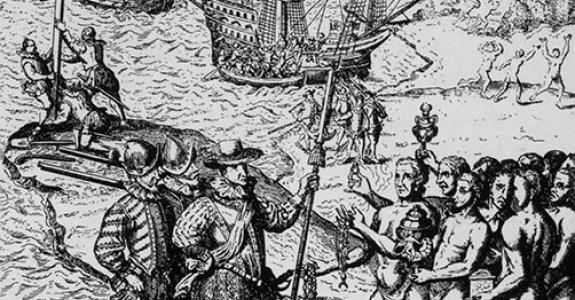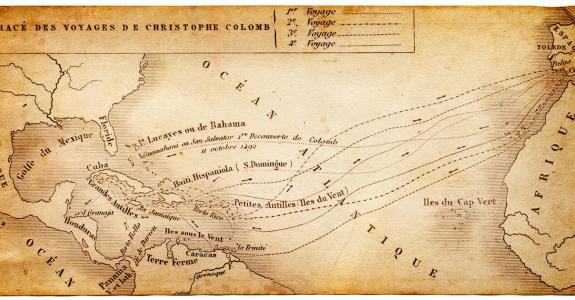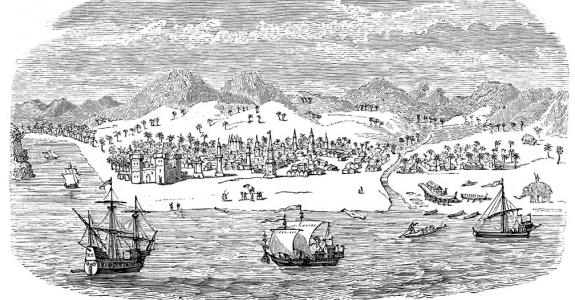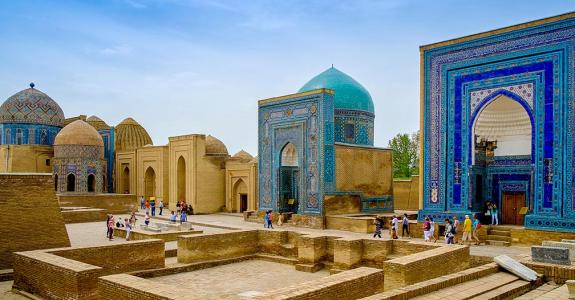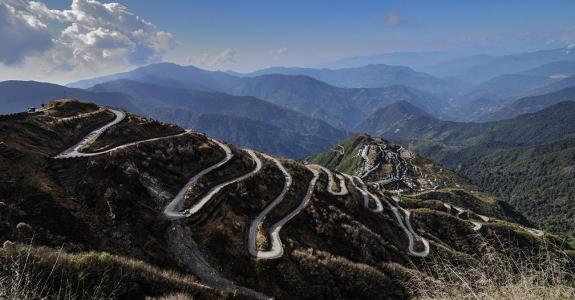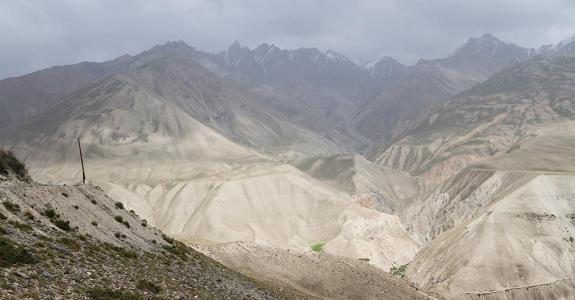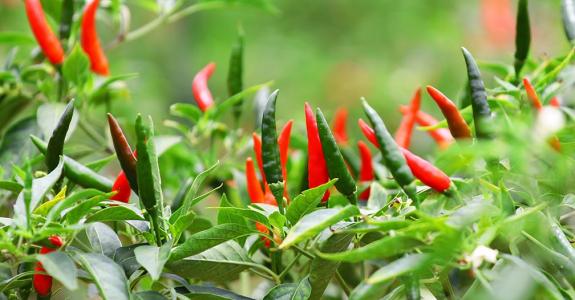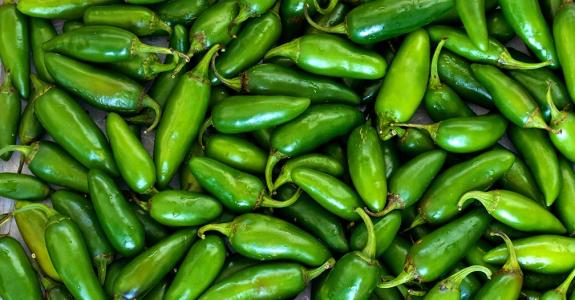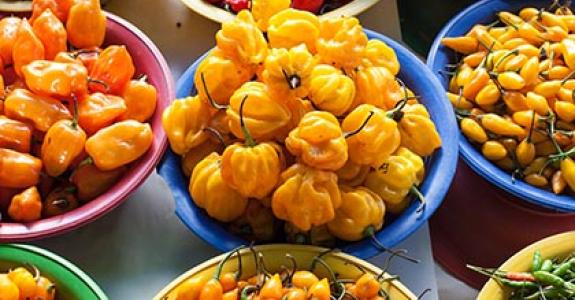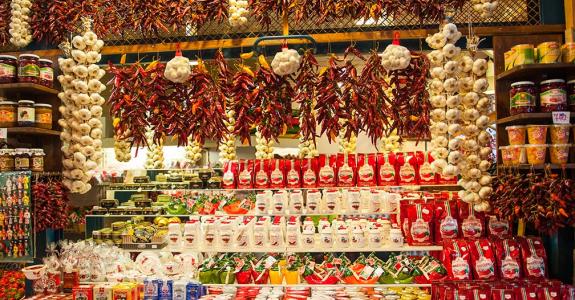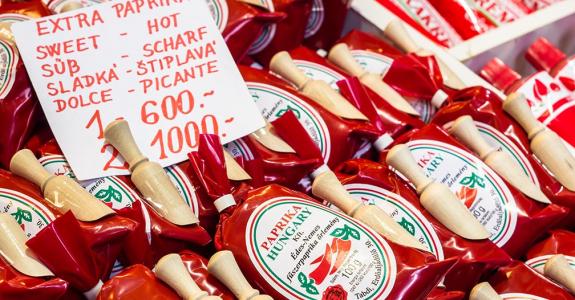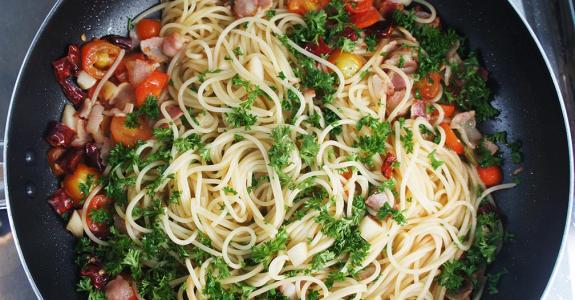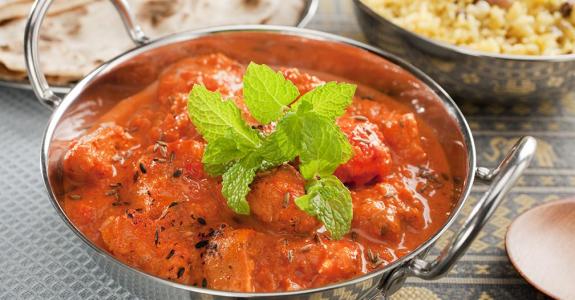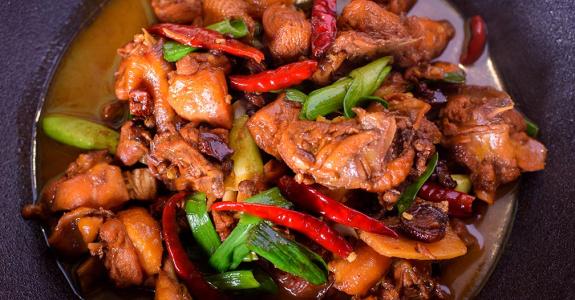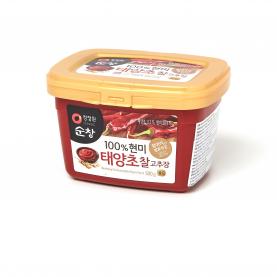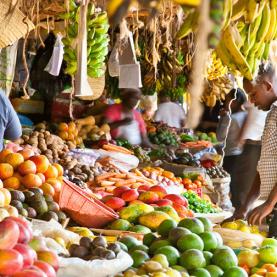Globetrotting chilli peppers
In our collective imagination, brightly coloured, spicy or even fiery chilli peppers evoke faraway lands and their exotic flavours. They have been incorporated so well into so many culinary traditions that it is far from easy to guess their origin. Thailand? Mexico? Cameroon? Or perhaps India?
Chilli, a 9000-year-old history
As a member of the Solanaceae family, the chilli pepper (Capsicum annuum) stands alongside tomatoes, potatoes and aubergines. It originates from Bolivia and the adjacent regions. Birds that can eat the pods without experiencing a burning effect, quickly spread chilli pepper seeds throughout South America, Central America and Mexico. Nine thousand years ago, pre-Colombian civilisations used chilli extensively to season their food, and we know that the Aztecs added it to what they called xocolatl, a kind of cocoa beverage flavoured with vanilla and other spices. Chilli was grown widely in these lands and was highly respected and used as a remedy. Meanwhile, the rest of the world remained unaware of this plump little fruit.
Christopher Columbus was the first European to discover chilli peppers on his voyage to the Americas. He found them on Hispaniola, one of the largest Caribbean islands which is now divided into two countries, Haiti and the Dominican Republic. He recorded the discovery in his ship’s log: “There is also plenty of agi, which is their pepper, which is more valuable than black pepper, and all the people eat nothing else, it being very wholesome.”1 When he returned from his expedition in 1493, he brought chilli back by ship to present to the Spanish court. However, the spicy fruit was not greeted with the intended success.
At that time, Europe was experiencing a period of shortage of Asian spices. After several centuries of flourishing business, greatly enriching Venetian merchants, trade was facing a major crisis. With the growing wealth of the urban bourgeoisie, who sought to imitate the ostentatious lifestyle of the nobility, the demand for spices in Europe reached unprecedented proportions. At the same time, the Mamluks in Egypt and the Turks in Asia Minor began to tax merchants heavily. This combination of factors raised the price of spices steeply, proving particularly problematic for black pepper, the most popular and most traded spice. This triggered a keen search for an alternative to the famous Silk Road, in order to sidestep the middlemen so that spices could be bought directly at source. Finding a maritime route to the Indies therefore became an obsession.
This was the backdrop against which Christopher Columbus embarked with his three caravels, seeking to open up a sea route to the Indies that avoided the circumnavigation of Africa. He decided to set his course due west, to “buscar el Levante por el Poniente”, to reach the East via the West.2 Instead of bringing back coveted spices from his first voyage, he arrived with chilli peppers. He called them “Indies pepper”3, as indicated in letters from his doctor, Diego Alvarez Chanca. Attempts were made to cultivate them and, very soon, the seeds he had brought back produced fruiting plants. However, the nobility considered chilli as having too strong a taste. The fact that the plant was undemanding and grew well in the Mediterranean climate only served to increase this rejection, as chilli could not lay claim to the aura of prestige that surrounded the spices arriving from the Indies and the Moluccas. Many even believed that the latter had magical powers. Cinnamon, pepper and nutmeg came from faraway lands swathed in legend and mystery. These spices travelled great distances before reaching European grocers’ stalls, a long journey which included desert crossings on camel back and the navigation of several tropical seas, not to mention the constant risk of pirate attack and natural disasters. For centuries, spices were therefore extremely expensive and remained the preserve of the ruling class, distinguishing it from the working people.
The modest chilli pepper thrived in any garden, yet failed to capture people’s imagination, let alone become a source of lucrative trade. Those hoping to become wealthy from this new spice were disappointed. Chilli was relegated to the rank of ‘poor man’s pepper’, and it was indeed the most impoverished who adopted it to enhance the flavour of their simple, mostly vegetarian sustenance.
The Indian adventure
Vasco de Gama also aspired to reach the mythical Spice Islands, but by a different route altogether. Contrary to Christopher Columbus, in 1497 he chose to head south along the west coast of Africa. Ten years earlier, in 1487, another Portuguese seafarer, Bartolomeu Dias, had discovered a cape at the far south of the African continent, which made it possible to imagine circumnavigating Africa. It was named the Cape of Good Hope as the Portuguese were now hopeful of reaching the Indies by sea. Soon after, in 1498, Vasco de Gama reached Calicut, on the Malabar Coast, and the dream of an entire epoch had been realised, as a new route to the Indies opened up.
Vasco de Gama returned from this first expedition with holds full of pepper, the same kind of pepper that the wealthy class liked to consume so ostentatiously. This earned him a triumphal return to Lisbon, leaving no doubt as to which continent he had visited, while Christopher Columbus, who had failed to find the spices he set out for, remained uncertain. Had he perhaps discovered a ‘New World’?
The Portuguese colonised Goa by force of arms, and imposed their presence along the west coast of India to assert their control over the spice trade. They brought with them the chilli pepper discovered by Columbus in the Americas yet disdained by the European aristocracy. The spicy red fruit, unknown until then, was an immediate hit with the local population. The south Indians in particular, accustomed to spicing their food with plenty of black pepper and long pepper, swiftly discovered the potential of chilli and incorporated it in their cuisine. It is no exaggeration to say that chilli became an essential ingredient in the preparation of their dishes, enhancing the flavour of rice, vegetables and lentils, to the point of being considered as one of the hallmarks of Indian cuisine.
Chilli then spread rapidly throughout the world. Following the Silk Road, it entered Afghanistan and reached Samarkand, from where it continued its route to Nepal and China. Apparently the Turks ferried it together with other spices on their trading route from India and added it to their cuisine. During the invasion of Hungary in 1526, the Turks introduced chilli, giving Hungarians a taste for dishes spiced with paprika.
In 1500, the Portuguese, once again on route to ‘the Indies’, discovered Brazil and found peppers known locally as quijà or quiya. From there, they transported them by boat, together with other foodstuffs such as corn, manioc and pineapple, to African shores such as the Gulf of Guinea, Angola and Mozambique. Chilli provided a welcome boost of flavour to the diet in Sub-Saharan Africa, until then based on nutritious but rather neutral-tasting plants such as yam, sorghum and millet.
As for the Spanish, they still toyed with the idea of trading directly with Asia. As a result of the Treaty of Tordesillas, which, in 1494, divided the world between the Spanish Empire and the Portuguese Empire along a meridian 370 leagues (1770 km or 46°37’) west of the Cape Verde Islands, the Spanish were unable to take the sea route around Africa. This maritime route was the exclusive preserve of their neighbours. This led the Spanish to pursue their exploration of Central America, and then to set out from Acapulco and Lima across the Pacific, finally reaching Asia. Chilli travelled with them, west to Manila and from there to southern China.
Blending into different cuisines
Shortly after Christopher Columbus became acquainted with chilli, it spread to all the warm regions of the globe, superseding black pepper and revolutionising culinary traditions. Today, it is a common spice and one of the most widely grown in the world.4 Chilli is used fresh or dried, whole or powdered, and sometimes smoked (like the renowned chipotle, obtained from drying and smoking jalapeño peppers), to prepare spicy sauces commonly used as seasoning. It is consumed in many different ways around the world: in Vietnam people crunch on a whole chilli pepper over the course of a meal, while in Martinique, a Habanero pepper (a very hot variety also known as bondamanjak) is cut in half and rubbed over food before eating it. Spaghetti aglio olio peperoncino in Italy (spaghetti with garlic, olive oil and chilli pepper), gulyásleves in Hungary (goulash soup), and Gong bǎo chicken in China are all specialities that bear witness to the incredible journey chilli has taken, not to mention the countless varieties of curries to which Indian and Thai cuisines are now inextricably linked.
The temperate regions of the globe baulked chilli peppers for a long time but, in the last few decades, chilli has made a comeback in Europe with an explosion of enthusiasm for exotic cuisines, in particular Indian, Thai and Vietnamese. Chicken tikka masala (a somewhat revamped Indian chicken curry) has become one of the most popular dishes in the United Kingdom. Robin Cook, former UK Foreign Minister (1997-2001), even declared in 2001 that: “Chicken Tikka Masala is now a true British national dish, not only because it is the most popular, but because it is a perfect illustration of the way Britain absorbs and adapts external influences.”5



